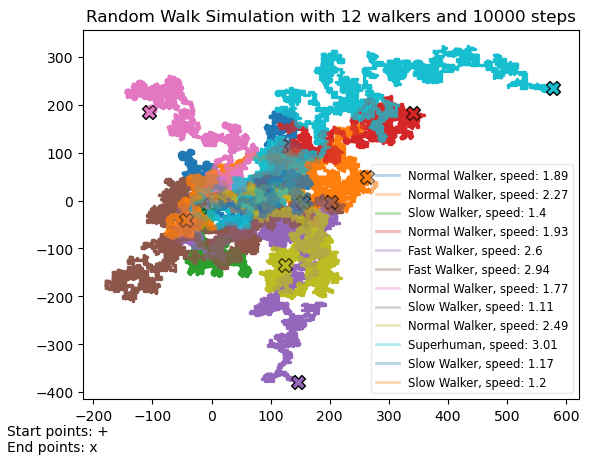In this project plots with simulations of randomized walks are generated.
"A random walk is a mathematical object, known as a stochastic or random process, that describes a path that consists of a succession of random steps on some mathematical space such as the integers. An elementary example of a random walk is the random walk on the integer number line, which starts at 0 and at each step moves +1 or -1 with equal probability" (Source).
This project aims to simulate a random walk simulation with different options and further implementations. The main implementations are:
- Simulation of multiple random walkers with different speeds
- High randomization of speeds, start points, colorization etc.
- Enabling options to simulate the random walk of your needs like different neighborhood movement patterns (Neumann/Moore), enabling random start points, running the code multiple times, saving the plot and/or results automatically...
- TBD: 3D walks
- TBD: impenetrable objects
To run the program every machine having at least Python 3.9 installed is suitable. Your Python environment should additionally include the libraries numpy, matplotlib and pandas. The rest should be included in the python installation. If you are using Linux or Mac, you should check the relative paths beforehand.
Create your virtual python environment and clone the repository. You should then be ready to execute the program.
The program is structured as explained below:
- variables for the number of walks and steps are defined (user-generated)
- the user can specify if a plot should be saved and how many times the code should be executed in total
- additionally the movement pattern can be chosen (4 or 8 directions)
- this leads to the definition of two arrays in form of x and y-coordinates with zeros..
- ..that are filled with random generated values through a for-loop for each walker
- the starting point in form of x and y can be randomized for each walk, otherwise all walkers start at 0,0
- the randomized choice of speed is implemented in the loop and is randomized for every walker
- with the definition of the class Walkers a detailed dataframe for every walk is generated which contains information about the type of walker, the starting point and the speed
- finally the dataframe can be saved as a CSV-file and the walks are plotted together in one figure
- if the user specified that there should be multiple runs, this process is automatically repeated
Call the program without any arguments to access the help within the terminal with information on how to use the optional arguments:
$ python src/main.py
usage: main.py [-h] [-s Steps] [-w Walkers] [-m Movepattern] [-xy Startpoint] [-p Save plot] [-r Runs]
Simulate a random walk with n walkers for n steps. You can use the following options to change the simulation to your needs. Have fun!
optional arguments:
<<<<<<< HEAD
-h, --help show this help message and exit
-s Steps, integer Integer | Number of total steps every walker shall take.
Default value: 1000
-w Walkers, integer Integer | Number of total walkers to be created.
Default value: 1
-m Movepattern, bool Boolean | Choose neighborhood movement pattern between
Neumann (4 directions, false) or
Moore (8 directions, true, default)
-xy Startpoint, bool Boolean | Do you want different (random) start points for
each walker (true, default) or
let all plots start at 0,0 (false)?
-p Save plot, bool Boolean | Do you want to automatically save the plot locally
(in ./data/)? Use true/false. Default: false
-r Runs, integer Integer | Total runs of the script (generate multiple plots if
wished). Default value: 1
=======
-h, --help show this help message and exit
-s Steps Integer | Number of total steps every walker shall take. Default value: 1000
-w Walkers Integer | Number of total walkers to be created. Default value: 1
-m Movepattern Boolean | Choose neighborhood movement pattern between Neumann (4 directions, false) or Moore (8 directions, true, default)
-xy Startpoint Boolean | Do you want different (random) start points for each walker (true, default) or let all plots start at 0,0 (false)?
-p Save plot Boolean | Do you want to automatically save the plot locally (./data/)? Use true/false. Default: false
-csv Save csv Boolean | Do you want to automatically save the results as csv-file locally (./data/)? Use true/false. Default: false
-r Runs Integer | Total runs of the script (generate multiple plots if wished). Default value: 1
>>>>>>> 69b4521fbe8972619f3f511f600468fdc26eb50a
Due to the high randomization of the simulation the following possible results are shown only exemplarily.
Options: 25 walkers, 25000 steps, default values and saving the plot
$ python src/main.py -s 25000 -w 25 -p true
Options: 10000 steps, 12 walkers, start point at 0,0, movement pattern Neumann and saving the plot
$ python src/main.py -s 10000 -w 12 -xy false -m false -p true
With default values only
$ python src/main.py
...
You can run the program with the default values.
Want to run it now? Use y/n: y


